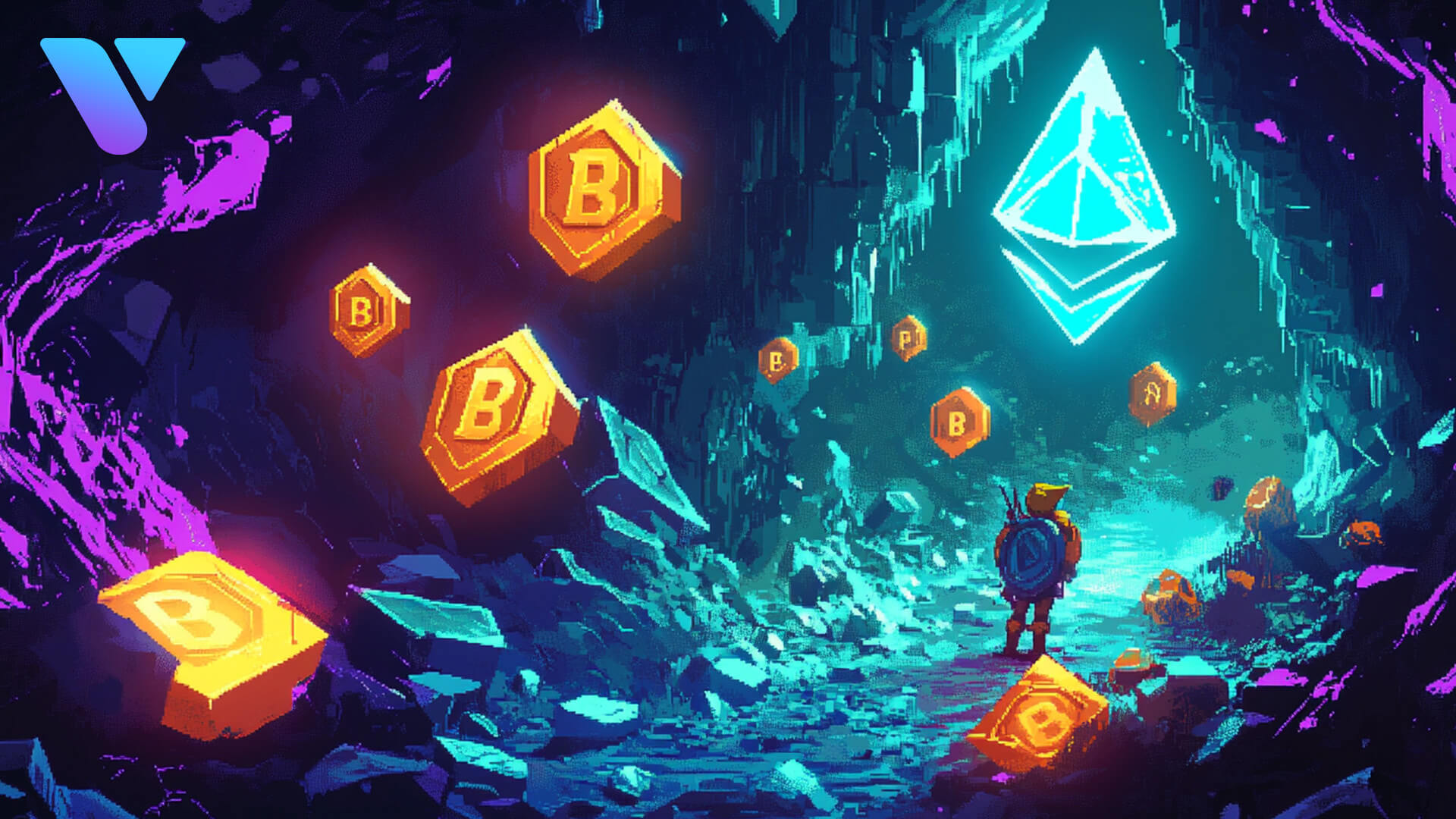Web3 gaming is here to shake up the industry, ditching old rules while leveraging blockchain technology to create brand new ways of doing things.
It’s not just about playing games anymore. It’s about players owning a slice of the action and being a part of online gaming communities they vibe with. It’s about game developers connecting more with their gamers. It’s about open marketplaces where game developers, content creators, and players can all get some cash equal to their efforts.
Making it a reality isn’t necessarily going to be easy, though – there are bumps in the road and challenges to overcome (innovation isn’t for the faint of heart!). However, for marketers and developers with a taste for bold moves, the growth potential is massive. Buckle up – this isn’t the gaming industry you’re familiar with.
Want a smooth road for your web3 game? Reach out to see how our experts can help!
Chapters
- Traditional Monetization in Mobile Games
- Web3 Monetization Models
- Web3 Gaming Foundational Tenets
- Web3 Gaming: Potential vs. Reality
- Opportunities in Bridging the Gap
- Strategies for Sustainable Growth
- Key Takeaways
Traditional Monetization in Mobile Games
Before we dive into Web3, it’s good to understand where the games industry is coming from.
Before Web3 gaming burst onto the scene, mobile game monetization was stuck in two lanes: premium games and freemium / free-to-play (F2P) games. Premium games charge upfront like an exclusive club (but you do get everything inside once you’ve paid). Meanwhile F2P games let players in for free, but then do one of two things (or sometimes a little of both): 1) charge you for the food, drinks, music, and club accessories through in-app purchases (also known as microtransactions); or 2) periodically interrupt the dancing with advertisements.
These monetization models still rule the gaming industry, shaping not only how developers make bank but also how players experience gaming.
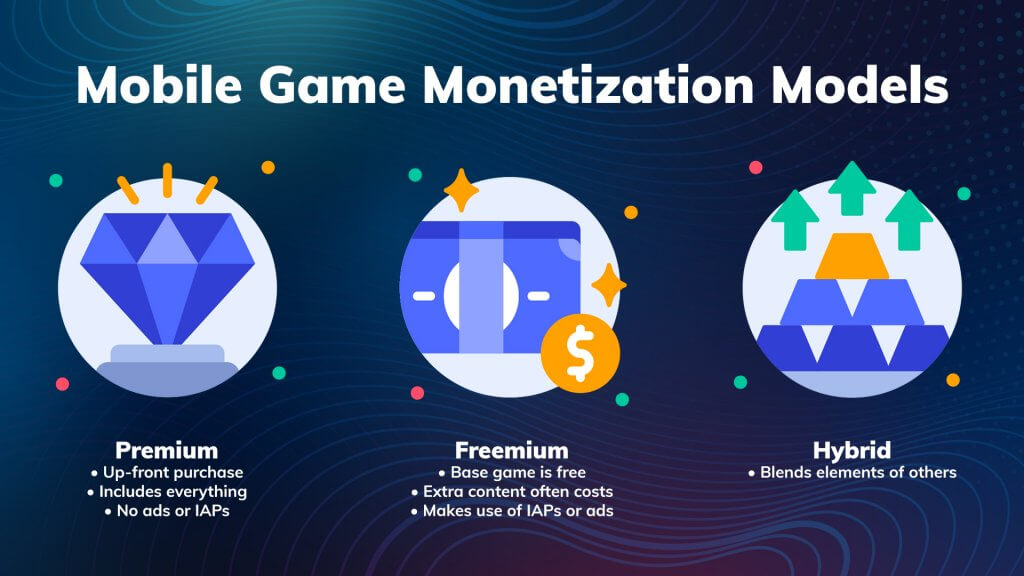
Premium Games
Premium games keep it simple: you pay once, you get the whole game – no missing pieces, no in-app purchases. Back in the early days of mobile gaming, this was the way to monetize gamers, and it’s still the main way that PC and console games monetize their players. Premium games cater to players who want high-quality, polished experiences and are happy to pay upfront for it.
Freemium (Free-to-Play) Games
When the iPhone burst onto the scene in 2007, and the Apple App Store was released shortly after, the world changed forever. The freemium / F2P model didn’t just gain traction – it left premium games eating its dust in mobile game revenue generation. Freemium monetization turned things upside down, letting players download and play games for free while sprinkling in ads or optional purchases – even both – to keep the cash flowing.
The freemium / F2P monetization model became the go-to for game developers and marketers looking to scale fast. This monetization magic comes from two main revenue streams:
- In-game advertisements: The backbone of freemium monetization. Developers rake in revenue from every impression and click, turning game sessions into prime real estate for marketers and advertisers.
- Microtransactions / in-app purchases (IAPs): The heavy hitter of freemium games, microtransactions and in-app purchases let players spend real cash on virtual goodies like skins, upgrades, and bonus content – which adds up to big bucks for game developers.
Freemium games aren’t just profitable – they’re an absolute cash cow, raking in a jaw-dropping 78% of the gaming industry’s revenue. Their secret? Accessibility. By offering free entry to the gaming party, they hook everyone from casual gamers killing time to hardcore players chasing the leaderboard. This broad appeal has cemented freemium games as a dominant force in gaming – to the point that microtransactions and ads have begun to leak into premium games.
Hybrid Monetization Models
As gaming economies leveled up, developers did too. Many have started embracing hybrid monetization strategies. Why stick to one model when you can have it all? These hybrids mash together premium pricing, in-app purchases (IAPs), ads, and sometimes even subscription-based revenue into one big, money-making machine.
The beauty of this approach? It lets developers cater to everyone – from the “I’ll pay for quality” diehards to the “I just want to chill” casuals – while getting the most out of every monetization opportunity available.
Web3 Monetization Models
These traditional game monetization models serve as a solid foundation for understanding the wild innovation Web3 gaming aims to bring to gaming – and the hurdles it faces doing so. For marketers, developers, and investors, it’s a crash course in how far we’ve come – and how much farther we can go!
That’s because Web3, with its blockchain-powered core, aims to flip the script on player-game relationships. Say hello to shiny new monetization models like Play-to-Earn (P2E) and Play-and-Own (P&O), where ownership, community, and transparency take center stage.
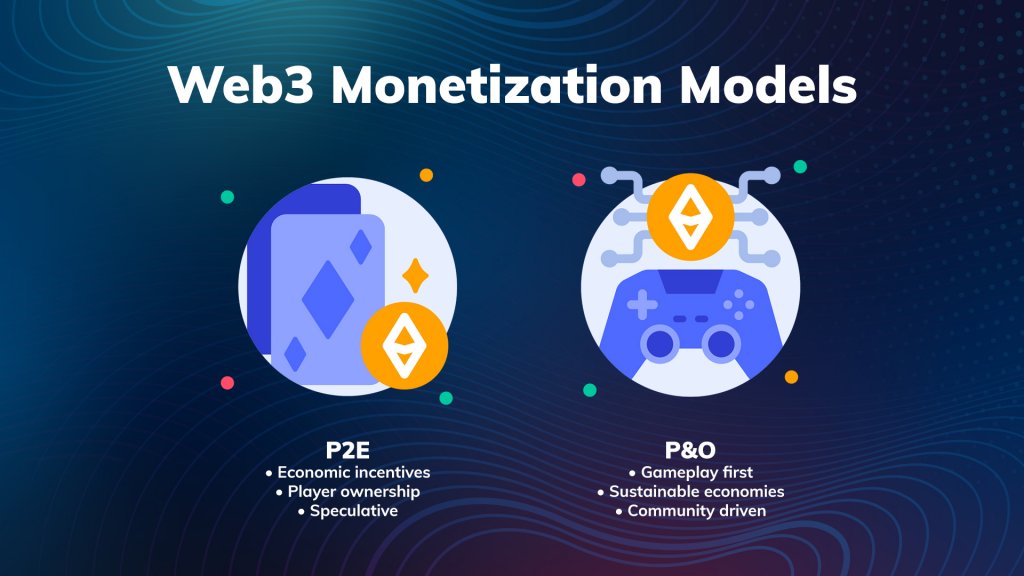
Play-to-Earn (P2E) Model
Play-to-Earn (P2E) games – the poster child of early Web3 gaming – didn’t just rewrite the rules; they tossed out the old playbook. These games invite players into blockchain-driven economies where gameplay is rewarded with assets that actually matter. That’s right, we’re talking actual cash here. Through non-fungible tokens (NFTs), these digital goodies can be traded, sold, or put to work in the game’s ecosystem. P2E isn’t just about playing; it’s about profiting. Some of the standout features of P2E games include:
- Economic Incentives: Who doesn’t love getting paid to play games? P2E games grab players with the promise of tradable assets, attracting not just traditional gamers but fostering brand new player demographics – including those eager to turn their gaming hours into dollar signs. Goodbye hobby, hello side hustle.
- Player Ownership: P2E gives gamers complete control by giving them full ownership over their earned assets. Web3’s decentralization empowers gamers to trade, sell, or flaunt their loot in open markets, making them active contributors to the broader game economy.
- Challenges: It’s not all rainbows and NFTs. The P2E model often gets so hung up on money-making that it forgets the “fun” in gaming. Critics argue these games can feel more like spreadsheets with graphics than actual immersive experiences, raising serious questions about long-term sustainability and player retention.
Play-and-Own (P&O) Model
The Play-and-Own (P&O) model of web3 games is like P2E’s cooler, more balanced sibling. It takes the flashy idea of asset ownership and gives it a glow-up by focusing less on quick profits and more on creating games people actually enjoy playing (imagine that!). By blending ownership with fun, community, and emotional connection, P&O games aim for sustainability and deeper player engagement. Here’s how:
- Gameplay First: In the world of Play-and-Own (P&O) games, fun takes the wheel, and profits ride shotgun. These games put engaging storytelling and immersive mechanics front and center, reminding everyone that gaming is supposed to be, well, fun. Sure, there are economic rewards, but they’re more like the cherry on top, not the whole dessert.
- Sustainable Economies: P&O games are literally playing the long game. By balancing asset ownership with actual in-game utility, they create value that lasts beyond hype. NFTs, for example, can double as customizable avatars or tools for creative expression, instead of just being shiny collectibles to flip. It gives your digital assets an ongoing purpose, instead of just a price tag.
- Community-Centric Design: P&O games aren’t just about playing – they’re about building. These games thrive on collaborative environments where players become co-creators, not just button mashers. From designing assets to shaping storylines, or even voting on governance decisions, players are handed the keys to the kingdom. It’s a gaming ecosystem where everyone gets a say.
Comparing P2E and P&O
- Focus: P2E is all about the money, bringing in players who are there to grind for cash and status. P&O, on the other hand, puts fun front and center – focusing on enjoyment, good community vibes, and sustainable game design.
- Challenges: P2E often gets dragged for feeling more like a speculative stock market than a game, leaving the “play” in “gameplay” as an afterthought. P&O addresses this, but has to walk a tightrope. Players still need to be able to cash out in a marketplace. However, in-game utility needs to be compelling enough that assets mostly remain in-game (but not so compelling that it completely fubars the economy).
- Audience: P2E pulls in the financially driven crowd, those who see NFTs as a potential quick paycheck. Meanwhile, P&O captures a broader audience – players who want the perfect combo of entertainment, ownership, and a sense of belonging in their digital world.
How do Web3 game developers actually make money?
As you may have noticed, a big component of these Web3 monetization models is paying the players. Given that, how do game developers actually get paid themselves in such an ecosystem? A lot of it comes down to token sales and resales. Mints and token events can raise some serious cash – and thanks to the beauty of blockchain technology, whenever an NFT is resold on a marketplace, the NFT creators (in this case, the game developers) can get a cut of the sale into perpetuity. Obviously, this means developers are heavily reliant on token sales… which may be a bit of a problem (that we’ll get to later in the article)!
Web3 Gaming Foundational Tenets
Web3 gaming isn’t just an upgrade – it’s a potential revolution in how games are imagined, built, and played. Powered by decentralized blockchain technology, this next-gen frontier redefines player engagement, ownership, and community interaction. Web3 games are writing a new playbook that sets them apart from their predecessors based on these core pillars:
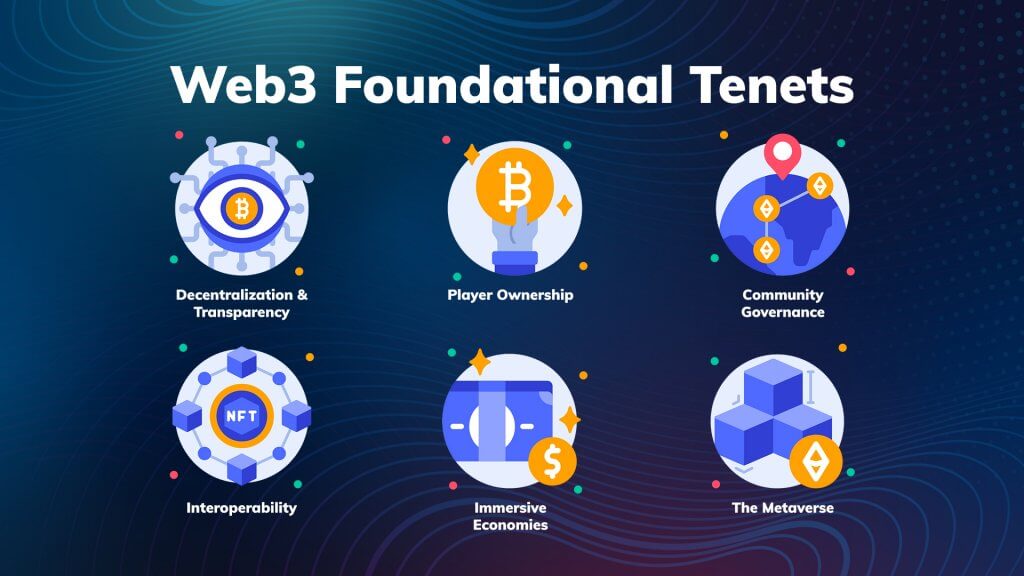
Decentralization and Transparency
With blockchain technology at its core, Web3 gaming eliminates the need for centralized gatekeepers like game publishers and distributors. Instead, it puts players in the driver’s seat, fostering transparency by empowering them to interact directly with game systems and economies. Smart contracts do the heavy lifting, enforcing rules and handling transactions in a way that is completely transparent – ensuring accountability. Gone is the reliance on opaque entities.
Player Ownership
A cornerstone of Web3 gaming is the concept of true ownership. A player’s in-game assets aren’t just digital decorations – they own them. Represented as non-fungible tokens (NFTs), these assets can be traded, sold, or even carried into other games and platforms. Say goodbye to the closed ecosystems of traditional gaming, where your hard-earned loot stays locked up forever. Web3 flips the script, giving players full control and real-world value over their virtual treasures.
Community Governance
In Web3 gaming, players don’t just play games – they’re decision-makers. Thanks to decentralized autonomous organizations (DAOs), players get a seat at the table – voting on everything from game updates to economic policies. Think of it as crowdsourced game development, where collaboration meets a sense of shared ownership. For game developers and marketers, this player-first approach isn’t just innovative – it’s a surefire way to build loyalty and community.
Interoperability
Why should your prized sword, epic skin, or beloved character be stuck in just one game? Web3 games break down these walls, enabling asset portability across titles and platforms. Thanks to the nature of blockchains, players can take their NFTs – whether they be items, characters, or something else – on a cross-game adventure. This weaves together a richer, more dynamic gaming ecosystem.
Immersive Economies
With blockchain technology, Web3 game economies aren’t just more secure than traditional game economies – they’re thriving. Players can trade peer-to-peer, play to their heart’s content, or even dive into the action as developers or designers. Whether a gamer is creating, playing, or simply trading, these economies bring Web3 games to life, delivering real value in ways traditional gaming never dreamed of.
The Metaverse
Because of Web3 games’ immersive economies, interoperability, communal governance, and player ownership, they’re often seen as the most tangible version of a metaverse. These aren’t just games anymore; they’re part of an ecosystem where the virtual and real worlds collide
Take The Sandbox, for example. Players can create and sell games or design in-game assets to be used in existing titles. And the potential doesn’t stop there – as mentioned above, there’s a real possibility of entire libraries of games built with cross-game assets, where what you earn or unlock in one game can be carried over to another. It’s not just playing – it’s investing, creating, and innovating in a fully immersive digital economy.
Back in the Web2 era, gaming became more social and accessible. Web3 games can take those trends and run like the wind with them – adding baked-in communities, vibrant marketplaces, and real-world rewards.
Web3 Gaming: Potential vs. Reality
Looking at those foundational tenets, the hype around Web3 gaming is understandably hard to ignore. With its decentralized blockchain foundation, it promises us game-changing concepts like true ownership of digital assets, community-driven ecosystems, and cutting-edge game economies.
There is certainly loads of enthusiasm in the core technology – all you have to do is look at the rise of crypto, NFT, and DAO usage by consumers, corporations, and even governments. Additionally, Web3 games, such as Upptic partner Axie Infinity, have millions of monthly active players.
Massive amounts of venture capital have also been thrown into the nascent space. At this point, billions upon billions of dollars have been invested into web3. Companies like Andreessen Horowitz have even created funds dedicated to building the next generation of gaming.
But now it’s time for some real talk, because the gap between the dream and the current reality is… wide, to say the least. Below, we break down the shiny potential of Web3 games versus the not-so-glamorous state of where things actually stand.
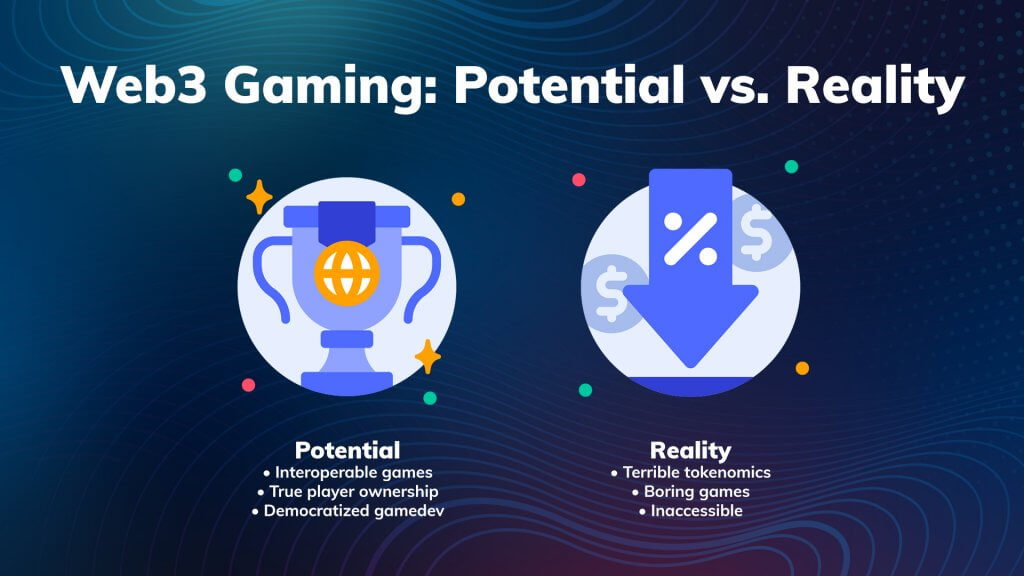
The Promise: Revolutionizing Digital Ownership
Web3 gaming came in hot, promising to revolutionize how players interact with their digital assets. With blockchain-based NFTs, the idea of true ownership became a reality – players can trade their in-game loot across marketplaces and, in theory, carry it across different interoperable games. This is a massive leap from the Web2 gaming days, where buying a shiny new skin meant locking it into a single ecosystem forever.
But wait, there’s more! Web3 isn’t just about owning your stuff – it’s about democratizing game development and governance. Through Decentralized Autonomous Organizations (DAOs), players can vote on game updates, marketing strategies, and more – creating a sense of shared purpose. Throw in new economic models like Play-to-Earn (P2E) and Play-and-Own (P&O), and you’ve got a recipe for combining fun with financial incentives.
On paper, it’s a gamer’s dream.
The Reality: Stagnation and Growing Pains
And now for the plot twist: reality. Despite all the shiny promises, Web3 gaming has hit some serious roadblocks – ranging from monetization and investor priorities to gameplay and gamer experiences.
Tokenomics
One glaring issue? The obsession with tokenomics over gameplay. Early Web3 titles often felt more like investment schemes than actual games, leaving players unimpressed and disillusioned.
Then there’s the pressure cooker of premature token launches. Developers are so busy trying to maintain token value for investors that the games themselves take a backseat – never a good look, and never sustainable.
Uninspired NFTs
There are also few best practices, standards, or definitive architecture in Web3. Additionally, as Arrivant CEO Cedric Gamelin notes, many people are simply using NFTs as microtransactions 2.0 – rather than in more innovative and unique ways.
Given that some gamers still have reservations about microtransactions, their expectation of how game developers will implement NFTs have understandably been met with hostility. And that taste gets worse for people who feel that Web3 games are released in a poor state, give uneven power to those with more capital, and exploit players to build assets.
Ethical Concerns
There are also ethical concerns from people in the industry about paying people to play games. Some consider P2E, or crypto in general, to essentially be ponzi schemes. Additionally some game developers have voiced concerns about fun and enjoyment becoming secondary or even tertiary in game design, instead of front-and-center.
Lack of Standout Titles
The Web3 space has also been plagued by a lack of standout titles. In its place lie multiple overambitious projects that have failed to deliver – leaving little wonder why market sentiment seems to have cooled.
Accessibility and Onboarding
High entry costs and onboarding processes often feel like a crash course in crypto – with the need to have a crypto wallet, integrate said wallet, and so on.
To survive, Web3 games need to ditch the speculative hype and focus on what really matters: sustainable growth, engaging gameplay, and delivering on their revolutionary promises. Because at the end of the day, most players want games they can actually play (and want to play) – not just half-baked ideals, broken promises, and tokens that, far too often, lose their value.
Opportunities in Bridging the Gap
The future of Web3 gaming isn’t about going full blockchain zealot – it’s about finding that sweet spot where quality game design meets the unique perks of decentralization.
Enter the rise of “Web 2.5” gaming, where traditional gaming frameworks holistically incorporate blockchain elements without shouting it from the rooftops. Games like Pirate Nation, Fableborn, and Off The Grid are leading the charge with a bold but simple philosophy: gameplay first, blockchain second. Because let’s be honest – players care more about having fun than figuring out what an NFT is.
And let’s not forget one of Web3’s biggest roadblocks: accessibility. The next wave of Web3 games must focus on seamless, invisible blockchain integration – making the tech a bonus feature, not a barrier to entry. The goal? A gaming experience so good, players won’t even realize they’re riding the blockchain wave.
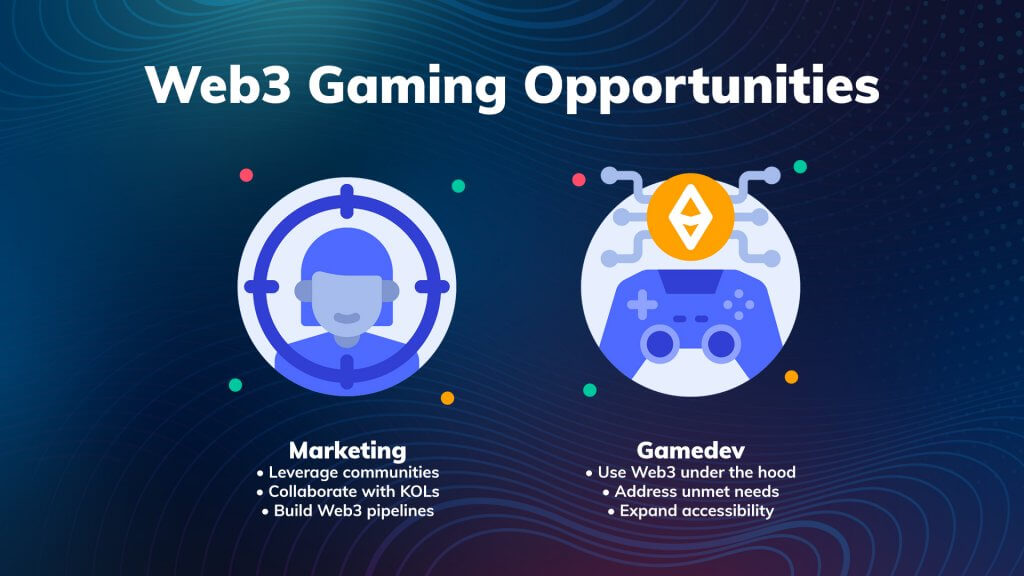
Opportunities for Game Marketers
Let’s face it – there’s a disconnect between Web3 gaming and mainstream audiences. But where there’s a gap, there’s also opportunity, and savvy game marketers can swoop in to make the connection.
Leveraging Community-Centric Platforms
In Web3 gaming, the party isn’t on Facebook or Instagram – it’s happening in Discord and Telegram. These decentralized hangouts are where players thrive, and marketers can build genuine relationships by leaning into:
- Direct interaction with players: Host AMA (Ask Me Anything) sessions, actually listen to feedback, and keep communication open. Trust and loyalty don’t come pre-minted – they’re earned.
- Hosting events and airdrops: Nothing gets players buzzing like exclusive events and shiny rewards. Organize virtual hangouts or in-game quests, and increase retention by sprinkling in airdrops to keep them coming back.
- Fostering community-led content creation: Fan art, game mods, memes – when players create, they’re not just engaged, they’re all in. So encourage them to get creative! Use forums and social media to solicit fan-made creations and highlight them on your official channels or even in-game!
Influencer Collaborations
Forget flashy ads! In Web3 marketing, it’s all about Key Opinion Leaders (KOLs) and influencers who get it. By partnering with the right voices (that is: ones who love your game), you can:
- Build credibility among blockchain-savvy audiences: Influencers rooted in the Web3 gaming space add instant authenticity to your marketing.
- Drive organic growth through trusted endorsements: Trusted voices beat video ads any day. Collaborate with KOLs who make it look effortless.
- Facilitate user education about blockchain elements: NFTs, tokenomics, DAOs – let influencers break down complex blockchain concepts so you don’t have to.
Navigating the Pivot from Paid Advertising
Paid ads are tricky in Web3. Native web3 players are turned off by traditional advertising. Meanwhile, mainstream gamers see every web3 ad as a scam. Winning campaigns are largely organic and lean on:
- Growth through community engagement: Get players engaged with online forums, social challenges, and collaborations. Build loyalty; the rest will follow.
- Storytelling that resonates: Show real player success stories or epic gameplay moments. Gamers don’t want to hear your pitch; they want to feel the experience.
- Transparency and trust-building: Be upfront. Talk about where funds are going and your project milestones. Trust matters, especially when scams still abound.
- Using paid ads once it makes sense: Organic growth through KOLs and communities is critical for targeting web3-native gamers. But if your Web3 tech is under the hood and seamless (see our opportunities for game developers below!), then you can bridge the gap between Web3 and Web2 with more traditional mobile game marketing strategies.
Innovative Campaign Strategies
Forget cookie-cutter strategies – Web3 games demand highly engaging bold moves. Here’s how to push the envelope:
- Gamified engagement: Launch challenges where players earn rewards by exploring new game features. Fun + prizes = win.
- Cross-platform campaigns: Use familiar Web2 platforms, like Twitch and X (formerly Twitter), to reel in new audiences, then wow them with Web3 magic.
- Personalized incentives: Reward your loyal fans with exclusive content, early access, or ultra-rare NFTs. Keep them invested – literally – to encourage retention and word-of-mouth promotion.
Building the Pipeline for Web3 Marketing and Attribution
Web3 marketing isn’t just new; it’s a blank slate. Marketers have the unique chance to set the standard in Web3 marketing and attribution by:
- Developing tools that track user engagement across decentralized platforms: These tools can measure player activity, token transactions, and asset trades to provide actionable insights.
- Creating frameworks for measuring the effectiveness of blockchain-native campaigns: Impressions and clicks are so Web2. Design frameworks that focus on wallet activations, token circulations, and community growth to gauge success.
- Partnering with analytics providers: Collaborate with Web3-friendly data platforms to create attribution models that actually work in decentralized ecosystems.
Capitalizing on these opportunities will elevate marketers from mere promoters to indispensable architects of the next generation of gaming. By leading the charge in Web3 games and embracing innovation, marketers can unlock fresh growth opportunities and pioneer new game industry standards.
Opportunities for Game Developers
There’s no use denying it – many Web3 gaming projects have struggled to deliver on their promises, leaving players underwhelmed and critics rolling their eyes. But where others have dropped the ball, sharp Web3 game developers can swoop in and capitalize on the gaps. From raising the bar on quality to redefining player experiences, the opportunities are wide open for those ready to build smarter.
Realizing the Potential of Web3 Technology
On the mainstream gaming side, there is significant untapped potential for integrating Web3 elements and hooking gamers – while avoiding the buzzwords – such as:
- Selling NFTs as unique in-game assets: From characters and skins to virtual real estate, NFTs turn collectibles into tradable treasures, giving players something to flaunt and profit from.
- Open marketplaces for asset trading: Let players cash in on their rare items and tokens. After all, why hoard when you can monetize?
- Interoperable assets across games: Imagine gear and characters that work in multiple titles. Suddenly, your game’s loot isn’t just worthwhile in your game, it’s valuable across an entire ecosystem.
- Customizable and dynamic NFTs: Items that evolve with gameplay? Yes, please! Add some personalization and watch exclusivity and value skyrocket.
- Early supporter rewards: Limited-edition items and tokens for early adopters? It’s a proven formula for building community, establishing loyalty, and creating buzz!
Addressing Unmet Needs in Game Quality
Web3 games have struggled to match the production quality of mainstream games. It’s unfortunate, but true. Developers can capitalize on this fact, and turn things around, by:
- Investing in high-quality graphics and immersive storytelling: Gamers expect AAA standards, and anything less won’t cut it. Match or exceed the standard, or get out!
- Focusing on a good user experience: Smooth controls, polished interfaces, and seamless gameplay aren’t optional – they’re essential.
- Bridging the gap between Web3 and traditional expectations: Adhere and exceed mainstream gaming standards while sprinkling in blockchain magic to keep both traditional gamers and crypto enthusiasts hooked.
Expanding Reach Through Accessibility
Want more players? Make web3 games easier to play! Here’s how:
- Simplify onboarding processes: Wallet creation and blockchain integration should be as easy as downloading the game. No crypto PhDs required.
- Free-to-play options: Give players a taste of the action before asking for a dime. If the game’s good, they’ll stick around.
- Seamless blockchain integration: Let the tech work behind the scenes so players can enjoy perks like asset ownership without getting headaches from wrangling blockchain tech.
By tackling these challenges and bridging the gap between web2 and Web3, game developers can attract a wider pool of gamers while positioning themselves as the future of gaming.
Strategies for Sustainable Growth
Too many Web3 games have been hyped to the moon only to crash and burn when players realize it’s basically a glorified crypto exchange. But here’s the good news: The blueprint for sustainable growth is right here. From prioritizing gameplay that keeps players hooked to building ecosystems that actually make sense, these strategies aren’t just suggestions – they’re survival skills for developers who want to stay in the game.
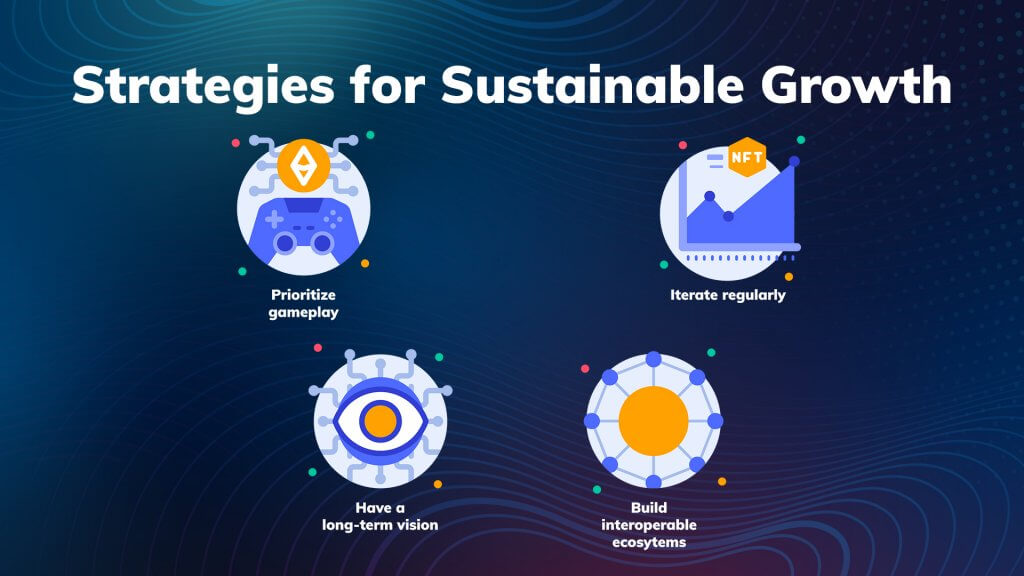
Prioritizing Gameplay Quality
Let’s get one thing straight: No one’s sticking around for a game that feels like Coinbase in disguise. Web3 developers need to focus on delivering addictive gameplay and immersive stories, with blockchain features as sweet, sweet icing – not the whole cake. Games like Pirate Nation and Parallel are already proving that prioritizing compelling mechanics and rich narratives is the way to win players over.
Iterative Development
You can’t just plant seeds and expect a garden to perfectly flourish. It requires regular maintenance and tweaking. Similarly, developers should adopt iterative processes:
- Alpha and beta testing: Get players involved early to squash bugs, refine mechanics, improve gameplay – and even build hype while they’re at it.
- Continuous player feedback loops: Listen to your community – seriously. They’ll tell you exactly what they want (and don’t want). Use their feedback to shape updates and ensure alignment with player preferences.
Long-Term Vision Over Hype
Overhype and premature token launches have burned more Web3 projects than we care to count. The solution? Play the long game:
- Make realistic promises: Set milestones you can actually hit. No one likes vaporware.
- Provide transparent communication: Be upfront about wins and challenges. It’s how you keep community trust intact.
- Delay tokenomics until product-market fit is achieved: Nail product-market fit first. Speculative elements can wait until the game has a solid foundation and loyal fanbase.
Building Interoperable Ecosystems
Want to wow players? Show them how Web3 games can connect in ways Web2 games never could:
- Cross-game asset utility: Let players carry their hard-earned loot and progress between titles. It’s like leveling up, but everywhere!
- Collaborations with other developers: Work with other creators to build shared virtual worlds that expand player engagement and keep things fresh.
Key Takeaways
Web3 gaming is brimming with opportunities for game marketers and developers to shake things up and redefine the industry. But, honestly, success isn’t about cramming blockchain into everything – it’s about putting players first. Prioritize quality gameplay that keeps them hooked, foster meaningful community engagement that turns fans into loyal advocates, and build sustainable economic models that don’t implode at the first sign of trouble.
By embracing these strategies and pushing the limits of what blockchain can do, the next wave of Web3 games can deliver on its promise to revolutionize gaming and marketing.
Have a Web3 game that you’re ready to level up? Reach out to us today – the future’s waiting!
Keep up with the latest insights from Upptic
Sign up for our monthly newsletter

